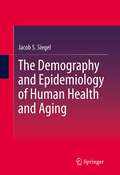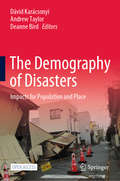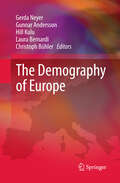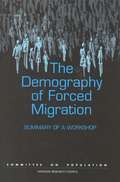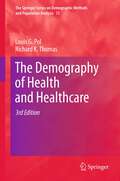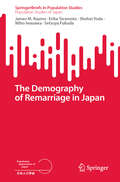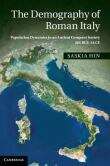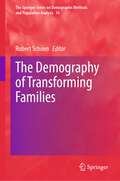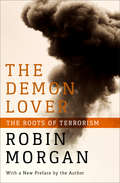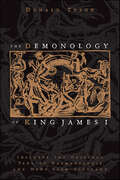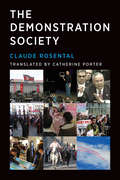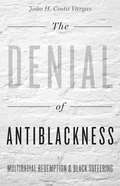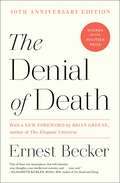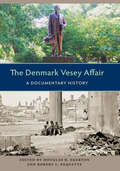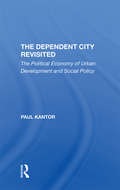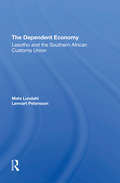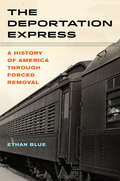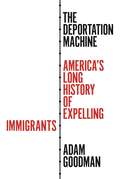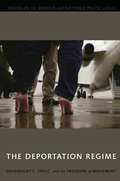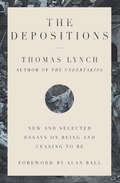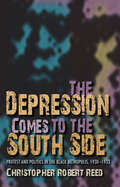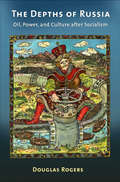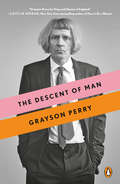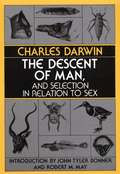- Table View
- List View
The Demography and Epidemiology of Human Health and Aging
by Jacob S. SiegelWith this book, Siegel, an internationally known demographer and gerontologist, has made a unique contribution to the fledgling fields of health demography, and the demography and epidemiology of aging. The book represents a felicitous union of epidemiology, gerontology, and demography, and appears to be the first and only comprehensive text on this subject now available. Drawing on a wide range of sciences in addition to demography, gerontology, and epidemiology, including medical sociology, biostatistics, public policy, bioethics, and molecular biology, the author treats theoretical and applied issues, links methods and findings, covers the material internationally, nationally, and locally, and while focusing on the elderly, treats the entire life course. The methods, materials, and pespectives of demography and epidemiology are brought to bear on such topics as the prospects for future increases in human longevity, the relative contribution of life style, environment, genetics, and chance in human longevity, the measurement of the share of healthy years in total life expectancy, the role of population growth in the rising costs of health care, and the applications of health demography in serving the health needs of local communities. The separate chapters systematically develop the topics of the sources and quality of health data; mortality, life tables, and the measurement of health status; the interrelationships of health, on the one hand, and mortality, fertility, migration, and age structure, on the other; health conditions in the less developed countries; the concepts and theories of aging and projections of the aged population; and local health applications, public health policy, and bioethical issues in health demography. Given its comprehensiveness, clarity, interdisciplinary scope, and authencity, this book appeals to a wide range of users, from students and teachers of medical sociology, the demography of aging, and public health studies to practitioners in these areas, both as a text in health demography and the demography/epidemiology of aging, and as a reference work in these fields.
The Demography of Blindness Throughout the World
by Hyman Goldstein<P>Most of the world's blindness could be prevented, and the attack on it and its consequences proceeds apace through such organizations as the World Council for the Welfare of the Blind, the International Agency for the Prevention of Blindness, and the World Health Organization. <P>For greatest effectiveness, their programs must be based upon accurate data, as a WHO study quoted here by Dr. Goldstein makes clear: "In order to establish appropriate priorities for prevention and treatment at the national and international level, it is essential that reliable up-to-date statistical data on prevalence, age of onset, and causes of blindness be obtained." <P>But even in the United States, where collection of data on blindness began in 1830, there are still no reliable trend data. In much of the rest of the world data are fragmentary, and data that would allow valid country by country comparisons are almost non-existent. <P>Dr. Goldstein has done a valuable service in pulling together such statistics as can be found, and in discussing their weaknesses and strengths.
The Demography of Disasters: Impacts for Population and Place
by Andrew Taylor Dávid Karácsonyi Deanne BirdThis open access book provides worldwide examples demonstrating the importance of the interplay between demography and disasters in regions and spatially. It marks an advance in practical and theoretical insights for understanding the role of demography in planning for and mitigating impacts from disasters in developed nations. Both slow onset (like the of loss polar ice from climate change) and sudden disasters (such as cyclones and man-made disasters) have the capacity to fundamentally change the profiles of populations at local and regional levels. Impacts vary according to the type, rapidity and magnitude of the disaster, but also according to the pre-existing population profile and its relationships to the economy and society. In all cases, the key to understanding impacts and avoiding them in the future is to understand the relationships between disasters and population change. In most chapters in this book we compare and contrast studies from at least two cases and summarize their practical and theoretical lessons.
The Demography of Europe
by Gunnar Andersson Gerda Neyer Laura Bernardi Christoph Bühler Hill KuluOver the past decades Europe has witnessed fundamental changes of its population dynamics and population structure. Fertility has fallen below replacement level in almost all European countries, while childbearing behavior and family formation have become more diverse. Life expectancy has increased in Western Europe for both females and males, but has been declining for men in some Eastern European countries. Immigration from non-European countries has increased substantially, as has mobility within Europe. These changes pose major challenges to population studies, as conventional theoretical assumptions regarding demographic behavior and demographic development seem unfit to provide convincing explanations of the recent demographic changes. This book, derived from the symposium on "The Demography of Europe" held at the Max Planck Institute for Demographic Research in Rostock, Germany in November 2007 in honor of Professor Jan M. Hoem, brings together leading population researchers in the area of fertility, family, migration, life-expectancy, and mortality. The contributions present key issues of the new demography of Europe and discuss key research advances to understand the continent's demographic development at the turn of the 21st century.
The Demography of Forced Migration: Summary of a Workshop
by Committee on PopulationInformation on The Demography of Forced Migration
The Demography of Health and Healthcare
by Richard K. Thomas Louis G. PolIn this 3rd edition of the definitive work on health demography, Pol and Thomas offer an updated view of the field and a current perspective on the applications of health demography to contemporary issues. The significance of health demography within the field of population studies has continued to increase and this work provides background on the healthcare arena and systematically presents the various aspects of demography as they relate to healthcare. This addition has been streamlined to focus on the important aspects of health demography and enhanced through the addition of charts, maps and other graphics. All statistics and tables have been updated and the most current references are included. A separate chapter on morbidity has been included and the final chapter focuses on the public policy interface with health demography. Case studies and sidebars are included throughout the book to illustrate the applications of demography within the healthcare arena. Recent developments in U.S. healthcare are highlighted to give the text a very contemporary presence.
The Demography of Remarriage in Japan (SpringerBriefs in Population Studies)
by James M. Raymo Miho Iwasawa Erika Teramoto Shohei Yoda Setsuya FukudaThis book provides the first comprehensive demographic overview of remarriage in Japan. Despite the fact that nearly one in five marriages in Japan now involves at least one formerly married spouse, very little is known about the nature of remarriages and how they differ from first marriages. One important focus of this book is to examine fertility intentions and outcomes in remarriages and to compare them with marriages in which both partners are in their first marriage. It is well known that low rates of first marriage contribute to Japan’s very low total fertility rate (TFR), but there is currently no theoretical or empirical basis for understanding how levels and patterns of remarriage are related to the TFR. To understand trends and patterns of remarriage in Japan, the book begins with an overview of the voluminous research literature on remarriage in the USA and other Western countries. This overview consists of a summary of trends and theoretical frameworks for understanding remarriage and is followed by a summary of existing research on correlates of remarriage and outcomes associated with higher-order marriages. Of particular importance is the attention paid to stepfamily fertility and the extent to which remarriage is associated with overall levels of fertility. An important contribution of this book is its presentation of basic descriptive information about levels and correlates of remarriage in Japan. These descriptive analyses are based on published data in the vital statistics reports and individual-level data from the National Fertility Surveys conducted by the National Institute of Population and Social Security Research and the National Survey of Households with Children conducted by the Japan Institute for Labour Policy and Training.
The Demography of Roman Italy
by Saskia HinThis book provides a fresh perspective on the population history of Italy during the late Republic. It employs a range of sources and a multidisciplinary approach to investigate demographic trends and the demographic behaviour of Roman citizens. Dr Hin shows how they adapted to changing economic, climatic and social conditions in a period of intense conquest. Her critical evaluation of the evidence on the demographic toll taken by warfare and rising societal complexity leads her to a revisionist 'middle count' scenario of population development in Italy. In tracing the population history of an ancient conquest society, she provides an accessible pathway into Roman demography which focuses on the three main demographic parameters - mortality, fertility and migration. She unites literary and epigraphic sources with demographic theory, archaeological surveys, climatic and skeletal evidence, models and comparative data. Tables, figures and maps enable readers to visualise the quantitative dynamics at work.
The Demography of Transforming Families (The Springer Series on Demographic Methods and Population Analysis #56)
by Robert SchoenThis book provides an up-to-date survey on the nature, causes, and patterns of family change. The traditional nuclear family has been replaced by a multiplicity of other forms, as widespread cohabitation, high levels of divorce and union dissolution, rising childlessness, and far below replacement fertility have emerged to an extent never before seen. Theoretical perspectives on this “Second Demographic Transition” are presented, highlighting the dramatic changes in gender roles. New methodological strategies for assessing family dynamics are presented, from multistate models of marriage and divorce combined with fertility to improved techniques for combining census and survey data on the family to a new approach for disentangling age, period, and cohort effects. While the volume emphasizes Western nations, insightful case studies range from analyzing family complexity in cohorts of parents and children in the UK to the impact of interpartner violence on family formation, to the emergence of a “gender war” in South Korea. By providing new insights into where we are today and how we got here, the book will be of value to all those interested in the contemporary family."Delayed Fertility as a Driver of Fertility Decline?" available open access under a Creative Commons Attribution 4.0 International License via link.springer.com.
The Demon Lover: The Roots of Terrorism
by Robin MorganA riveting exploration of terrorism&’s relationship to sex, with a new preface by the author Terrorism is the international crime that has captured the attention of the entire world, forcing governments to make radical changes in security and civil liberties. Meanwhile, everyone tries to comprehend the real reasons that inspire such violence. This is where political philosopher Robin Morgan begins The Demon Lover, a groundbreaking work of investigative journalism and a bestseller in the print edition. Through her globe-spanning examination of terrorism, Morgan unearths the roots of the phenomenon. With wide-ranging research across historical eras and a three-hundred-sixty-degree approach, she examines how violence has become eroticized—and conflated with masculinity—to the lethal detriment of both women and men. Recent scientific studies referenced in the preface to this edition prove just how ahead of her time Morgan has been with her analysis. Her account of her own personal experience with militant tactics adopted by US radicals in the 1960s and 1970s is extraordinary, and her reports on and interviews with Palestinian women in the refugee camps of the Middle East—women confiding for the first time, as women, details of their lives under terrorism every day—are deeply moving. Morgan also offers a compelling vision of hope for change, and an afterword includes her famous &“Letters from Ground Zero,&” written after 9/11.The Demon Lover is Robin Morgan at her most intelligent and unforgettable.
The Demonology of King James I: Includes the Original Text of Daemonologie and News from Scotland
by Donald TysonWritten by King James I and published in 1597, the original edition of Demonology is widely regarded as one of the most interesting and controversial religious writings in history, yet because it is written in the language of its day, it has been notoriously difficult to understand.Now occult scholar Donald Tyson has modernized and annotated the original text, making this historically important work accessible to contemporary readers. Also deciphered here, for the first time, is the anonymous tract News from Scotland, an account of the North Berwick witch trials over which King James presided.Tyson examines King James' obsession with witches and their alleged attempts on his life, and offers a knowledgeable and sympathetic look at the details of magick and witchcraft in the Jacobean period. Demonology features historical woodcut illustrations and includes the original old English texts in their entirety. This reference work is the key to an essential source text on seventeenth-century witchcraft and the Scottish witch trials
The Demonstration Society (Infrastructures)
by Claude RosentalToday, as in the past, public demonstrations are not only tools to prove, persuade, and promote, but also fundamental forms of social interaction and exchange.YouTube demos of makeup products by famous influencers, demonstrations of strength during street protests, demonstrations of military might in North Korea: public demonstrations are omnipresent in social life. Yet they are often perceived as isolated events, unworthy of systematic examination. In The Demonstration Society, Claude Rosental explores the underlying dynamics of what he calls a &“demonstration society.&” He shows how, both in today&’s world and historically, public demonstrations constitute not only tools to prove, persuade, and promote, but fundamental forms of interaction and exchange, and, in some cases, attempts to lead the world. Rosental compares demos with other forms of public demonstrations, drawing out both their peculiarities and common features. He analyzes the processes through which demonstrations are conceived and carried out, as well as the skills of their producers. He also compares contemporary demos with historical demonstrations including theaters of machines in the Renaissance, public demonstrations of natural philosophy in the seventeenth century, and demonstrations of the magic lantern in the nineteenth century. Above and beyond the entertainment they sometimes provide, demonstrations are experienced as intense moments that broadly involve alliances, material and symbolic goods, and, more generally, the future of individuals and collectives. Rosental elucidates the many ways in which we live today, as in the past, in a society of demonstration.
The Denial of Antiblackness: Multiracial Redemption and Black Suffering
by João H. VargasAn incisive new look at the black diaspora, examining the true roots of antiblackness and its destructive effects on all of society Thanks to movements like Black Lives Matter, Western society&’s chronic discrimination against black individuals has become front-page news. Yet, there is little awareness of the systemic factors that make such a distinct form of dehumanization possible. In both the United States and Brazil—two leading nations of the black diaspora—a very necessary acknowledgment of black suffering is nonetheless undercut by denial of the pervasive antiblackness that still exists throughout these societies.In The Denial of Antiblackness, João H. Costa Vargas examines how antiblackness affects society as a whole through analyses of recent protests against police killings of black individuals in both the United States and Brazil, as well as the everyday dynamics of incarceration, residential segregation, and poverty. With multisite ethnography ranging from a juvenile prison in Austin, Texas, to grassroots organizing in Los Angeles and Black social movements in Brazil, Vargas finds the common factors that have perpetuated antiblackness, regardless of context. Ultimately, he asks why the denial of antiblackness persists, whom this narrative serves, and what political realities it makes possible.
The Denial of Death
by Ernest BeckerWinner of the Pulitzer Prize, The Denial of Death explores how people and cultures around the world have reacted to the concept of death from celebrated cultural anthropologist Ernest Becker.Winner of the Pulitzer Prize in 1974 and the culmination of a life&’s work, The Denial of Death is Ernest Becker&’s brilliant and impassioned answer to the &“why&” of human existence. In bold contrast to the predominant Freudian school of thought, Becker tackles the problem of the vital lie—man&’s refusal to acknowledge his own mortality. In doing so, he sheds new light on the nature of humanity and issues a call to life and its living that still resonates decades after its writing.
The Denmark Vesey Affair: A Documentary History (Southern Dissent)
by Douglas R. Egerton Robert L. PaquetteA vast collection of documents that illuminate one of the most sophisticated acts of collective slave resistance in the history of the U.S. In 1822, thirty-four slaves and their leader, a free black man named Denmark Vesey, were tried and executed for "attempting to raise an insurrection" in Charleston, South Carolina. In The Denmark Vesey Affair, Douglas Egerton and Robert Paquette annotate and interpret a vast collection of contemporary documents that illuminate and contextualize this complicated saga, providing the definitive account of a landmark event that played a role in the nation’s path to Civil War. The editors ultimately argue that the Vesey plot was one of the most sophisticated acts of collective slave resistance in the history of the United States. A volume in the series Southern Dissent, edited by Stanley Harrold and Randall M. Miller Publication of the paperback edition made possible by a Sustaining the Humanities through the American Rescue Plan grant from the National Endowment for the Humanities.
The Dependent City Revisited: The Political Economy Of Urban Development And Social Policy
by Paul KantorHere is a book that makes sense of the L.A. riots, homelessness, tax giveaways, and the other big urban issues that are back in the national spotlight. In this streamlined and updated new edition of his classic book, The Dependent City, Paul Kantor now focuses on economic development and social welfare policies to reveal the key dilemmas of American urban politics. Returning to a political economy theme, Kantor explores how city governments have struggled to escape and accommodate the reality of their economic dependency in the policies that they've pursued. Revisiting cities across the nation, Kantor finds not only that they have become more dependent but also that the character of this dependency has changed and deepened. Exploring local regimes in the Frostbelt and Sunbelt and in suburbia, he finds that they frequently act more like captives of big business rather than as representatives of citizens. Local attempts to promote social justice increasingly run up against a wall of economic dependency created by federal policies and business power. This book signals how American cities can find ways of overcoming this dependency by working together with states and the federal government to promote healthy, democratic urban politics. The Dependent City Revisited is an accessible, provocative supplement for a wide variety of courses in urban studies and political economy as well as stimulating reading for anyone who is interested in understanding America's urban mosaic.
The Dependent Economy: Lesotho And The Southern African Customs Union
by Lennart Petersson Mats Ove LundahlThis book aims to analyze Lesotho's prospects for economic advancement, and examines the influence of the policies and economic development of South Africa on Lesotho's own potential for development.
The Deportation Express: A History of America through Forced Removal (American Crossroads #61)
by Ethan BlueA history of the United States' systematic expulsion of "undesirables" and immigrants, told through the lives of the passengers who travelled from around the world, only to be locked up and forced out aboard America's first deportation trains. The United States, celebrated as a nation of immigrants and the land of the free, has developed the most extensive system of imprisonment and deportation that the world has ever known. The Deportation Express is the first history of American deportation trains: a network of prison railroad cars repurposed by the Immigration Bureau to link jails, hospitals, asylums, and workhouses across the country and allow forced removal with terrifying efficiency. With this book, historian Ethan Blue uncovers the origins of the deportation train and finds the roots of the current moment, as immigrant restriction and mass deportation once again play critical and troubling roles in contemporary politics and legislation. A century ago, deportation trains made constant circuits around the nation, gathering so-called "undesirable aliens"—migrants disdained for their poverty, political radicalism, criminal conviction, or mental illness—and conveyed them to ports for exile overseas. Previous deportation procedures had been violent, expensive, and relatively ad hoc, but the railroad industrialized the expulsion of the undesirable. Trains provided a powerful technology to divide "citizens" from "aliens" and displace people in unprecedented numbers. Drawing on the lives of migrants and the agents who expelled them, The Deportation Express is history told from aboard a deportation train. By following the lives of selected individuals caught within the deportation regime, this book dramatically reveals how the forces of state exclusion accompanied epic immigration in early twentieth-century America. These are the stories of people who traveled from around the globe, only to be locked up and cast out, deported through systems that bound the United States together, and in turn, pulled the world apart. Their journey would be followed by millions more in the years to come.
The Deportation Machine: America's Long History of Expelling Immigrants (Politics and Society in Modern America #137)
by Adam GoodmanThe unknown history of deportation and of the fear that shapes immigrants' livesConstant headlines about deportations, detention camps, and border walls drive urgent debates about immigration and what it means to be an American in the twenty-first century. The Deportation Machine traces the long and troubling history of the US government's systematic efforts to terrorize and expel immigrants over the past 140 years. This provocative, eye-opening book provides needed historical perspective on one of the most pressing social and political issues of our time.In a sweeping and engaging narrative, Adam Goodman examines how federal, state, and local officials have targeted various groups for expulsion, from Chinese and Europeans at the turn of the twentieth century to Central Americans and Muslims today. He reveals how authorities have singled out Mexicans, nine out of ten of all deportees, and removed most of them not by orders of immigration judges but through coercive administrative procedures and calculated fear campaigns. Goodman uncovers the machine's three primary mechanisms—formal deportations, "voluntary" departures, and self-deportations—and examines how public officials have used them to purge immigrants from the country and exert control over those who remain. Exposing the pervasive roots of anti-immigrant sentiment in the United States, The Deportation Machine introduces the politicians, bureaucrats, businesspeople, and ordinary citizens who have pushed for and profited from expulsion.This revelatory book chronicles the devastating human costs of deportation and the innovative strategies people have adopted to fight against the machine and redefine belonging in ways that transcend citizenship.
The Deportation Regime: Sovereignty, Space, and the Freedom of Movement
by Nicholas De Genova Nathalie PeutzThis important collection examines deportation as an increasingly global mechanism of state control. Anthropologists, historians, legal scholars, and sociologists consider not only the physical expulsion of noncitizens but also the social discipline and labor subordination resulting from deportability, the threat of forced removal. They explore practices and experiences of deportation in regional and national settings from the U. S. -Mexico border to Israel, and from Somalia to Switzerland. They also address broader questions, including the ontological significance of freedom of movement; the historical antecedents of deportation, such as banishment and exile; and the development, entrenchment, and consequences of organizing sovereign power and framing individual rights by territory. Whether investigating the power that individual and corporate sponsors have over the fate of foreign laborers in Bahrain, the implications of Germany's temporary suspension of deportation orders for pregnant and ill migrants, or the significance of the detention camp, the contributors reveal how deportation reflects and reproduces notions about public health, racial purity, and class privilege. They also provide insight into how deportation and deportability are experienced by individuals, including Arabs, South Asians, and Muslims in the United States. One contributor looks at asylum claims in light of an unusual anti-deportation campaign mounted by Algerian refugees in Montreal; others analyze the European Union as an entity specifically dedicated to governing mobility inside and across its official borders. The Deportation Regime addresses urgent issues related to human rights, international migration, and the extensive security measures implemented by nation-states since September 11, 2001. Contributors: Rutvica Andrijasevic, Aashti Bhartia, Heide Castaeda , Galina Cornelisse , Susan Bibler Coutin, Nicholas De Genova, Andrew M. Gardner, Josiah Heyman, Serhat Karakayali, Sunaina Marr Maira, Guillermina Gina Nuez, Peter Nyers, Nathalie Peutz, Enrica Rigo, Victor Talavera, William Walters, Hans-Rudolf Wicker, Sarah S. Willen
The Depositions: New And Selected Essays On Being And Ceasing To Be
by Thomas LynchA wry and compassionate selection of essays reflecting on mortals and mortality, from the acclaimed author of The Undertaking. For nearly four decades, poet, essayist, and small-town funeral director Thomas Lynch has probed relations between the literary and mortuary arts. His life’s work with the dead and the bereaved has informed four previous collections of nonfiction, each exploring identity and humanity with Lynch’s signature blend of memoir, meditation, gallows humor, and poetic precision. The Depositions provides an essential selection from these masterful collections—essays on fatherhood, Irish heritage, funeral rites, and the perils of bodiless obsequies—as well as new essays in which the space between Lynch’s hyphenated identities—as an Irish American, undertaker-poet—is narrowed by the deaths of poets, the funerals of friends, the loss of neighbors, intimate estrangements, and the slow demise of a beloved dog. In “Gladstone,” from The Undertaking, Lynch reflects on his then twenty-five years as an undertaker at the Midwinter Conference for Michigan funeral directors, which incongruously takes place on an island in the Caribbean. With brutal, generous honesty, “The Way We Are,” from Bodies in Motion and at Rest, grapples with Lynch’s time as a single parent coming to terms with generations of his family inheritance of alcoholism and recovery. The press of the author’s own mortality animates the new essays, sharpening a curiosity about where we come from, where we go, and what it means. As Alan Ball writes in a penetrating foreword, Lynch’s work allows us “to see both the absurdity and the beauty of death, sometimes simultaneously.” With this landmark collection, he continues to illuminate not only how we die, but also how we live.
The Depression Comes to the South Side: Protest And Politics In The Black Metropolis, 1930-1933 (Blacks in the Diaspora)
by Christopher Robert ReedIn the 1920s, the South Side was looked on as the new Black Metropolis, but by the turn of the decade that vision was already in decline--a victim of the Depression. In this timely book, Christopher Robert Reed explores early Depression-era politics on Chicago's South Side. The economic crisis caused diverse responses from groups in the black community, distinguished by their political ideologies and stated goals. Some favored government intervention, others reform of social services. Some found expression in mass street demonstrations, militant advocacy of expanded civil rights, or revolutionary calls for a complete overhaul of the capitalist economic system. Reed examines the complex interactions among these various groups as they played out within the community as it sought to find common ground to address the economic stresses that threatened to tear the Black Metropolis apart.
The Depths of Russia: Oil, Power, and Culture after Socialism
by Douglas RogersRussia is among the world's leading oil producers, sitting atop the planet's eighth largest reserves. Like other oil-producing nations, it has been profoundly transformed by the oil industry. In The Depths of Russia, Douglas Rogers offers a nuanced and multifaceted analysis of oil's place in Soviet and Russian life, based on ethnographic fieldwork and archival research in the Perm region of the Urals. Moving beyond models of oil calibrated to capitalist centers and postcolonial "petrostates," Rogers traces the distinctive contours of the socialist--and then postsocialist--oil complex, showing how oil has figured in the making and remaking of space and time, state and corporation, exchange and money, and past and present. He pays special attention to the material properties and transformations of oil (from depth in subsoil deposits to toxicity in refining) and to the ways oil has echoed through a range of cultural registers. The Depths of Russia challenges the common focus on high politics and Kremlin intrigue by considering the role of oil in barter exchanges and surrogate currencies, industry-sponsored social and cultural development initiatives, and the city of Perm's campaign to become a European Capital of Culture. Rogers also situates Soviet and post-Soviet oil in global contexts, showing that many of the forms of state and corporate power that emerged in Russia after socialism are not outliers but very much part of a global family of state-corporate alliances gathered at the intersection of corporate social responsibility, cultural sponsorship, and the energy and extractive industries.
The Descent of Man
by Grayson PerryWhat does it mean to be male in the 21st Century? Award-winning artist Grayson Perry explores what masculinity is: from sex to power, from fashion to career prospects, and what it could become—with illustrations throughout.In this witty and necessary new book, artist Grayson Perry trains his keen eye on the world of men to ask, what sort of man would make the world a better place? What would happen if we rethought the macho, outdated version of manhood, and embraced a different ideal? In the current atmosphere of bullying, intolerance and misogyny, demonstrated in the recent Trump versus Clinton presidential campaign, The Descent of Man is a timely and essential addition to current conversations around gender. Apart from gaining vast new wardrobe options, the real benefit might be that a newly fitted masculinity will allow men to have better relationships—and that’s happiness, right? Grayson Perry admits he’s not immune from the stereotypes himself—yet his thoughts on everything from power to physical appearance, from emotions to a brand new Manifesto for Men, are shot through with honesty, tenderness, and the belief that, for everyone to benefit, updating masculinity has to be something men decide to do themselves. They have nothing to lose but their hang-ups.
The Descent of Man, and Selection In Relation to Sex
by Charles Darwin John Tyler Bonner Robert M. MayIn the current resurgence of interest in the biological basis of animal behavior and social organization, the ideas and questions pursued by Charles Darwin remain fresh and insightful. This is especially true of The Descent of Man and Selection in Relation to Sex, Darwin's second most important work. This edition is a facsimile reprint of the first printing of the first edition (1871), not previously available in paperback. The work is divided into two parts. Part One marshals behavioral and morphological evidence to argue that humans evolved from other animals. Darwin shoes that human mental and emotional capacities, far from making human beings unique, are evidence of an animal origin and evolutionary development. Part Two is an extended discussion of the differences between the sexes of many species and how they arose as a result of selection. Here Darwin lays the foundation for much contemporary research by arguing that many characteristics of animals have evolved not in response to the selective pressures exerted by their physical and biological environment, but rather to confer an advantage in sexual competition. These two themes are drawn together in two final chapters on the role of sexual selection in humans. In their Introduction, Professors Bonner and May discuss the place of The Descent in its own time and relation to current work in biology and other disciplines.
